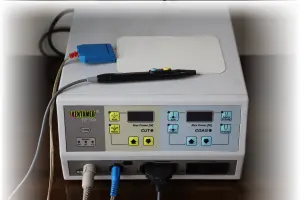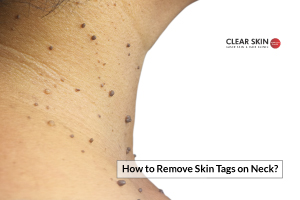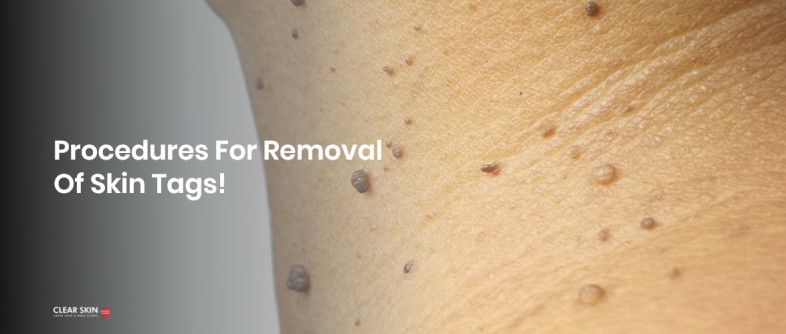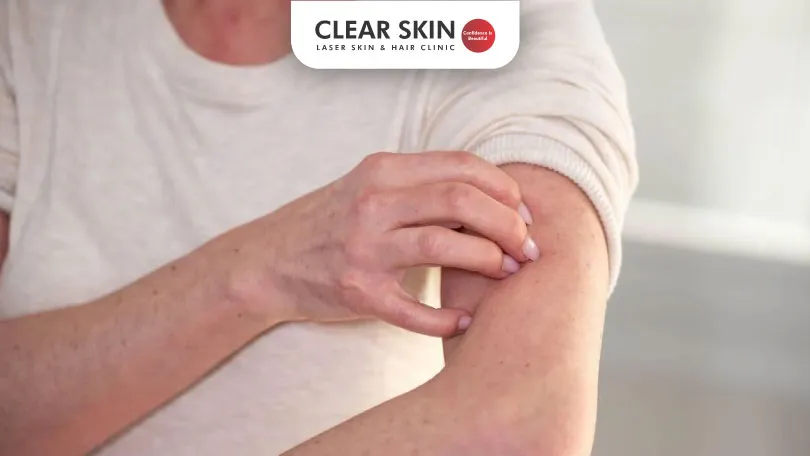Table Of Content
Skin Tag Removal Treatment in Pune
Skin tags, those small, stalk-supported growths on your Skin, need expert attention for safe removal. At Clear Skin, a renowned dermatologist clinic in Pune, we specialize in professional skin care and skin tag removal treatments. Our team is dedicated to providing effective solutions to not only remove skin tags but also restore your Skin's pristine appearance.
Causes of skin tags often include friction in skin folds, common in areas like the neck, armpits, and groin, along with factors like normal aging, genetic predisposition, and hormonal imbalances. While they rarely cause discomfort, if they become inflamed or infected, it's essential to seek the expertise of a skilled dermatologist in Pune. Whether you're looking to remove skin tags for cosmetic reasons or due to irritation, we at Clear Skin offer a variety of safe and effective skin tag removal methods, ensuring your Skin's health and beauty are in the best hands.
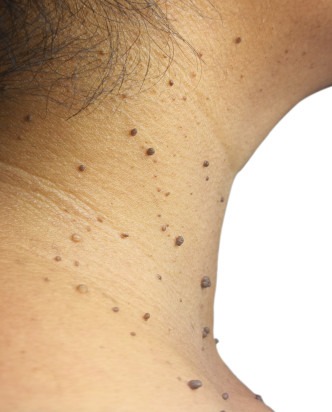
Table of Content
Understanding Skin Tags
Do & Don't after getting Skin tags removal treatment
Causes of Skin Tags
Skin tags Treatments
Understanding Skin Tags
Types of skin tag treatment for unwanted growth (or acrochordon, fibroepithelial polyp, cutaneous papilloma, soft fibroma) is a small, soft, benign skin growth, hanging off by a thin stalk or peduncle. However, these are not dangerous.
In fact, skin tags commonly appear in the following areas:
- Neck
- Chest
- Back
- Eyelids
- Armpits
- Under the breasts
- In the groin area.
Skin tags are usually flesh-coloured, varying in size and number. Moreover, skin tags are harmless. In fact, individuals want skin tag treatment to remove them for cosmetic purposes. However, they may cause discomfort when rubbed or twisted. Moreover, if skin tags change colour or size or start to pain or bleeding, it is important to consult a dermatologist.
Do & Don't after getting Skin tags removal treatment
DO: Use the prescribed antiseptic ointments to reduce inflammation and redness
DO: Keep the treated area dry.
DO: Follow the post-procedure care instructions.
DON’T: Try and remove the scab.
DON’T: Carry out a strenuous activity that will cause sweating at the treated area.
DON’T: Touch or cleanse the site without disinfecting the site.
DON’T: Allow friction or irritation at the site of treatment.
Causes of skin tags
- Prolonged rubbing of skin against skin
- Prolonged friction with jewellery
- Old age
- Obesity
- Genetics
- Hormonal changes
- Diabetes (type 2)
- Insulin resistance
- Pregnancy
Skin tags may occur in both males and females. Skin tags occur primarily in the middle-aged group. Moreover, the tendency to get skin tags increases with age.
Skin tags Treatments
A skin tag is usually painless and does not pose any health risks. However, the skin tag may appear unsightly and cause self-image issues. Therefore, individuals may want treatment for skin tag removal to improve cosmetic appearance. In fact, the doctor will recommend a procedure for skin removal after assessing the tag and the patients' expectations.
There are several treatment modalities to treat skin tags. In fact, both topical applications as well as surgical procedures are effective.
-
Topical applications:
1. Over-the-counter solutions: Creams and gels containing are available at pharmacies that claim to freeze the skin tag, causing it to fall off after 7-10 days. However, these should be absolutely avoided as they can cause complications like scarring, infection and pigmentation.
-
CO2 laser removal:
The CO2 laser treatment is the gold standard for skin tag removal. Moreover, laser treatment minimises the chances of infection and scarring. It is a safe treatment.
-
Surgical methods:
There is a step by step procedure prior to the surgery. The following steps are carried out:
- Sterilisation: The area to be treated is prepared by sterilizing the surrounding skin, with a disinfectant, to prevent infection.
- Anaesthesia: A local anaesthetic, lidocaine, is injected or applied topically to the site to minimize or prevent pain during the procedure.
- Removal: After ensuring that the anaesthetic has taken effect and the area to be treated is numb, the skin tag is snipped off.
a) Cryotherapy:
Dermatologists use liquid nitrogen to freeze the skin tag. In fact, this allows a very targeted application. This is important, because contact with liquid nitrogen may cause discomfort to the surrounding skin.
The treatment may take about 20-30 seconds, depending on the size and number of the tags. However, it may take about 2-3 weeks for the skin tag to blacken and fall off completely. This is not done commonly because of the chances of post-procedural hypopigmentation and scarring.
b) Electrotherapy/Electrocauterization:
This treatment for skin tag removal uses a high-frequency electric current to burn off the surface of the skin tag. In fact, this results in the easy and quick removal of the skin tag.
Dermatologists use a topical anaesthetic to numb the area before using the cautery. A scab forms after the procedure. One must use an antiseptic cream to avoid infection. The scab will fall off by itself within 7-10 days.
For treating your skin condition, feel free to get in touch with one of our best dermatologists in Pune. You can also call on +919584584111 to book an appointment at one of our skin clinics near you.
Skin Tag Treatment Success Stories

Skin tags removal disease are small growths on the skin. A thin stalk supports them. The main cause of skin tags is friction in skin folds in areas like the neck, armpits, and groin. Moreover, they rarely cause irritation and discomfort. However, if they become inflamed or infected, they should be removed. In fact, patients want to remove them for cosmetic reasons.
It works,
Says our Patients

Abhishek Sarkar
"I consulted Dr Shah where she explained about the procedure for removing skin tags. Consultation is awesome and fruitfull. Thank you very much."

Laxmi Pawar
"Most reliable and efficient doctors. The treatment to remove skin tags and the equipment are so nice and advance. As the tag line says say no to frustration. My all tags got removed without pain"

Saurabh Undre
"Good co-operation by all staff. Nice consultation and skin tag removal treatment. Good follow up regarding appointment. Nice facility."

Rupa Krothapalli
"I am happy with Clear Skin .nice staff very friendly I would suggest Punekar’s to visit Clear Skin for any skin related ailments and best diagnosis by the staff over there."
Treatment Timeline








































Clear Skin Ultimate Guides
How to Remove Skin Tags on Neck?
Table of Contents What are Skin Tags? Skin Tags Causes How to Remove Skin Tags? Skin Tags Removal Treatment How to Prevent Skin Tags on Neck? Skin tags are a common adult skin concern. Usually, they are harmless.... Read MoreProcedures For Removal Of Skin Tags!
Skin tags are small growths of skin, supported by a thin stalk. Often found in skin folds, in areas like the neck, armpits, and groin, they are harmless. Very rarely can they cause irritation and discomfort, becoming inflamed or... Read MoreClear Skin Insights
Non-Surgical Breast Reduction: Approaches for Smaller Breasts
How to Cope With Itchy Skin After Laser Hair Removal?
How to Get Smaller Breasts in 1 Week: Effective Tips and Strategies
Hydra Facial Treatment, Procedure & Why it is popular? | Clear Skin, Pune
FAQs
While undergoing acne treatment, you must avoid using products, including facial scrubs, masks, and astringents. They irritate the skin and can worsen acne. Also, one must avoid excessive washing and scrubbing to avoid skin irritation. Besides, avoid using any creams on the face. Consult a dermatologist before use.
Acne is a common occurrence in girls from ages 14 to 28. The time when acne disappears varies from person to person. However, in most cases, acne disappears in the mid-20s. Although in some ladies, acne keeps recurring and disappearing due to various factors.
In most cases, acne disappears on its own at the end of puberty. But in some cases, it may persist during the individual’s adulthood. Based on the dermatologist’s prescription, severe cases require laser treatment for active acne and for pigmentation post acne.
Acne’s last stage is Stage 4, which features severe acne. During this stage, acne can become extremely painful, and the person may suffer from nodules, papules, cysts, and pustules across the affected area. This grade lands up in severe scarring that becomes difficult to treat.
Permanent scarring can develop if you try to pick at or squeeze your acne rather than treating it or letting it heal on its own.
Acne can be avoided. Here are some tips to avoid acne from Clear Skin, the best doctor for acne treatment in Pune.
- Maintaining a clean skin
- Avoiding exposure to the sun
- Exercising daily
- Following a balanced diet
- Keeping the skin moisturized by using correct products for acne prone skin
In many cases, heredity is the reason for acne vulnerability. But other conditions like stress, lack of sleep, diet, dehydration, smoking, hormonal imbalance, etc., can also cause acne.
Acne and pimples result from increased sweating and sebaceous glands in the skin. In adolescence, the secretions of sweat and sebaceous glands are very active. They begin producing extra sebum, which clogs the pores with sebum, resulting in acne and pimples.
It is inflammation that causes pain. When one of the pores gets blocked with excess oil or bacteria, your immune system usually responds with inflammation to cure the problem.
Threading involves pulling the hair out from the follicle root. Pulling the hair opens the pore. If the area isn’t clean, bacteria can enter the pore, clog it and lead to a breakout.
After shaving, hair follicles can remain stuck in the skin due to the clogged pore and cause a red bump. But in addition to red bumps, the person may also experience itchiness, tenderness, and a burning sensation on the skin due to the infection around the hair follicle.
Usually, pimples last for about three to six or seven days if taken with proper consultation from a dermatologist. But deep pimples may take a few weeks to disappear.
There’s a range of food you must avoid to prevent pimples. Some of them include potato chips, dairy products, chocolates, sweets, white bread, doughnuts, pastries, fries, and puffed rice can lead to pimples.
It depends upon the case’s complexity, the number of sessions, etc. But the average cost per session is Rs. 2000 to Rs. 6000. For the most specific and the best acne treatment in Pune, connect with a dermatologist.
As you hit puberty, it’s seen that acne is one of the common problems suffered by all girls. Acne problems are suffered by 85% of teenagers and are common across both genders. Teenagers struggle hard to look pretty and fair and hence knowing how to get rid of acne holds importance for them.
The best workaround to resolve acne issues is to consult your doctor who would examine your skin type and based on it, will define what treatment option works best in your favor.
Dermatologists recommend topical solutions at first to rid your skin of excess oil and acne problems. It is only after prolonged problems that doctors recommend oral medications after asking their patients to go through multiple tests for hormones and learn about underlying factors possibly responsible for acne and pimple problems. Light-based therapies and extraction treatments are viewed in extreme cases when the patient responds to neither cream-based applications nor oral medicines.
Far from causing acne, birth control pills can be one of the effective ways to control acne. These birth control pills work amazingly in some females who are suffering from acne due to hormonal issues. These birth control pills consist of estrogen & progesterone. These hormones counteract the androgen (male hormone) present in the body which is responsible for causing acne.
Hormonal acne treatment depends on the severity of the condition. In milder cases, retinoid creams and gels which are available over the counter will work. In cases of severe acne, an antibiotic may be prescribed, in combination with retinoid cream that helps clear up any bacteria. Do not pick at or pop your hormonal acne as it may lead to permanent scarring.
Avoid layering your face with make-up products and remember to rid your face of all the make-up before you go to sleep. Ensure that you do not use strong hair products as the quality of your hair products may also affect your skin. Keep your scalp clean and keep the hair strands away from your face.
There is no specific gene that determines whether you may get acne or not, but genetics plays an important role as a determinant of whether you are more or less prone to acne. How effectively you can combat acne is also based on your genetics. The ability of the hair follicles to resist acne is linked with heredity. You are more likely to have acne during adolescence if this skin condition runs in the family or if one of your first-degree relatives has had acne.
Hormonal changes are among the common causes of acne. During the teens, or puberty, one experiences significant hormonal fluctuations. It is also the time when the sebaceous glands generate more oil under the impact of hormones. This is why acne is more common during the teens.

